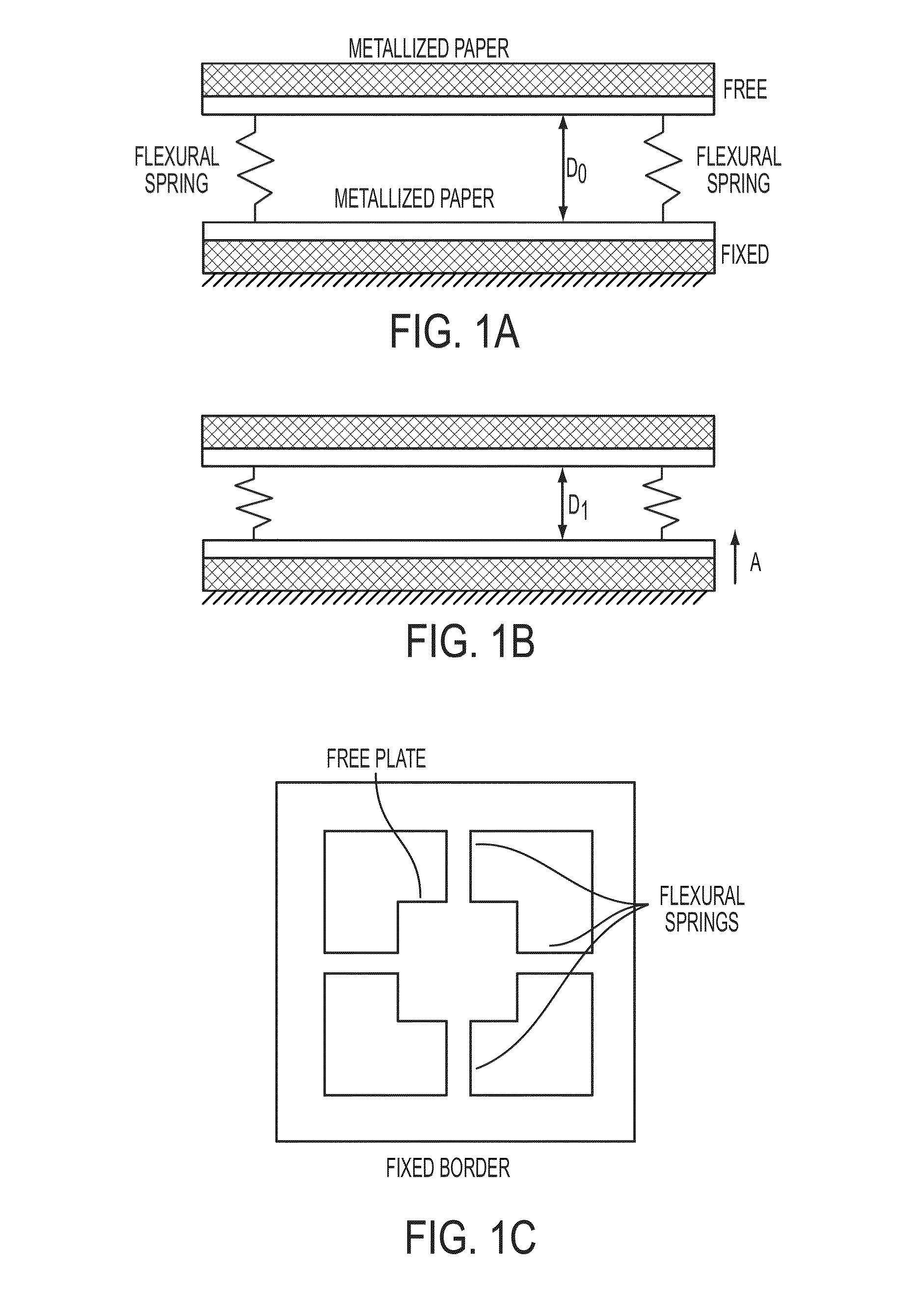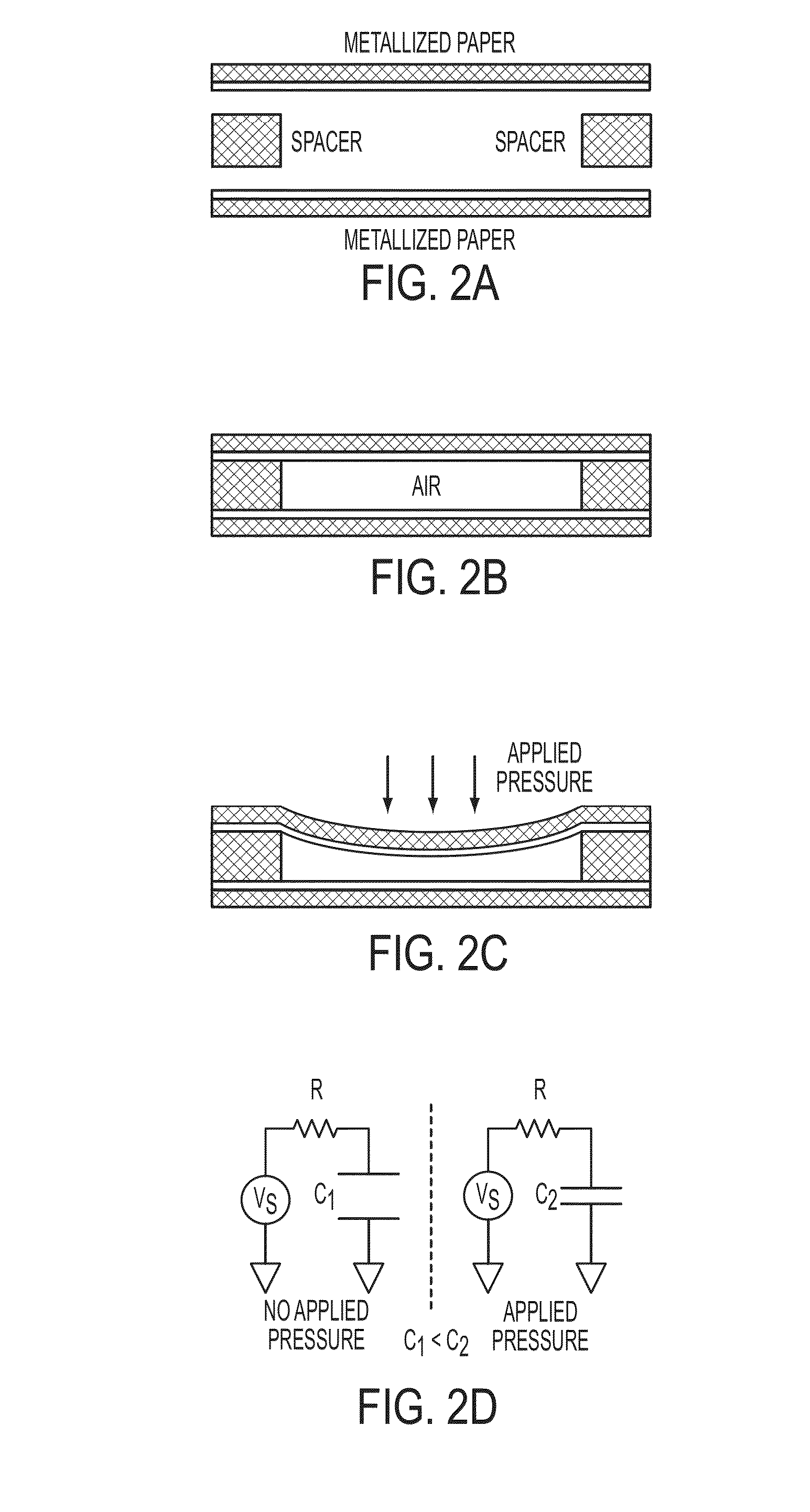Capacitive, paper-based accelerometers and touch sensors
a capacitive and paper-based technology, applied in the field of capacitive, paper-based accelerometers and touch sensors, can solve problems such as capacitance change, and achieve the effect of inexpensive application and storage, and low cos
- Summary
- Abstract
- Description
- Claims
- Application Information
AI Technical Summary
Benefits of technology
Problems solved by technology
Method used
Image
Examples
example 1
Fabrication of a Touch Sensor Based on Mechanical Compliance
[0202]An exemplary touch sensor based on mechanical compliance is illustrated in FIGS. 2A-C. This touch sensor was formed from two separate pieces of metallized paper (either Vacumet® A-550 or Vacumet® A-238) and a spacer (either double-sided tape (3M® Indoor Carpet Tape) or Whatman® 3MM chromatography paper). Sheets of metallized paper were cut to form the deflectable plate and the fixed plate. The spacer was cut to provide a gap of air between the fixed and deflectable plates when all three layers were adhered (see also FIG. 4A-D). All layers were cut using a VLS3.50 laser cutter (50-watt laser) from Universal Laser Systems with the standard 2.0″ lens. The three layers were then adhered. In the case of sensors fabricated using chromatography paper as the spacer, double sided tape was applied to the top and bottom of the spacer layer to adhere the fixed layer and deflectable layer. The resulting design permits the distance...
example 2
Fabrication of a Capacitive Coupling-Based Touch Sensor Containing an Exterior Conductive Layer and an Interior Conductive Layer
[0204]A representative capacitive coupling-based touch sensor containing an exterior conductive layer and an interior conductive layer is illustrated in FIGS. 3A-D and FIGS. 5A-B. This sensor does not include a gap of air serving as a dielectric material between the two conductive layers. Analogous sensors containing an air gap were also fabricated. These sensors operate using both mechanical compliance and capacitive coupling.
[0205]Metallized paper (either Vacumet® A-550 or Vacumet® A-238) was used to form the exterior conductive layer and the interior conductive layer. Both layers were cut using a VLS3.50 laser cutter (50-watt laser) from Universal Laser Systems with the standard 2.0″ lens. The perimeter of the exterior conductive surface was ablated using a laser cutter operated at a reduced power setting sufficient to ablate the conductive layer without...
example 3
Capacitive Coupling-Based Touch Sensors Containing Both an Active Electrode and a Grounded Electrode in Proximity to the Surface
[0210]A representative capacitive coupling-based touch sensor containing both an active electrode and a grounded electrode positioned in proximity to the surface of the touch sensor is illustrated in FIGS. 3E-H and FIGS. 5D-E.
[0211]This touch sensor was formed from a single sheet of metallized paper (either Vacumet® A-550 or Vacumet® A-238). The metallized paper was cut to the desired shape using a VLS3.50 laser cutter (50-watt laser) from Universal Laser Systems with the standard 2.0″ lens. The active and grounded electrode were then patterned by ablating the conductive metal layer using the VLS3.50 laser cutter. The laser cutter was operated at a reduced power setting sufficient to ablate the conductive layer without cutting completely through the metallized paper. For the Vacumet A-550 metallized paper, we used the setting of 6% power, 80% speed, and 500...
PUM
 Login to View More
Login to View More Abstract
Description
Claims
Application Information
 Login to View More
Login to View More - R&D
- Intellectual Property
- Life Sciences
- Materials
- Tech Scout
- Unparalleled Data Quality
- Higher Quality Content
- 60% Fewer Hallucinations
Browse by: Latest US Patents, China's latest patents, Technical Efficacy Thesaurus, Application Domain, Technology Topic, Popular Technical Reports.
© 2025 PatSnap. All rights reserved.Legal|Privacy policy|Modern Slavery Act Transparency Statement|Sitemap|About US| Contact US: help@patsnap.com



